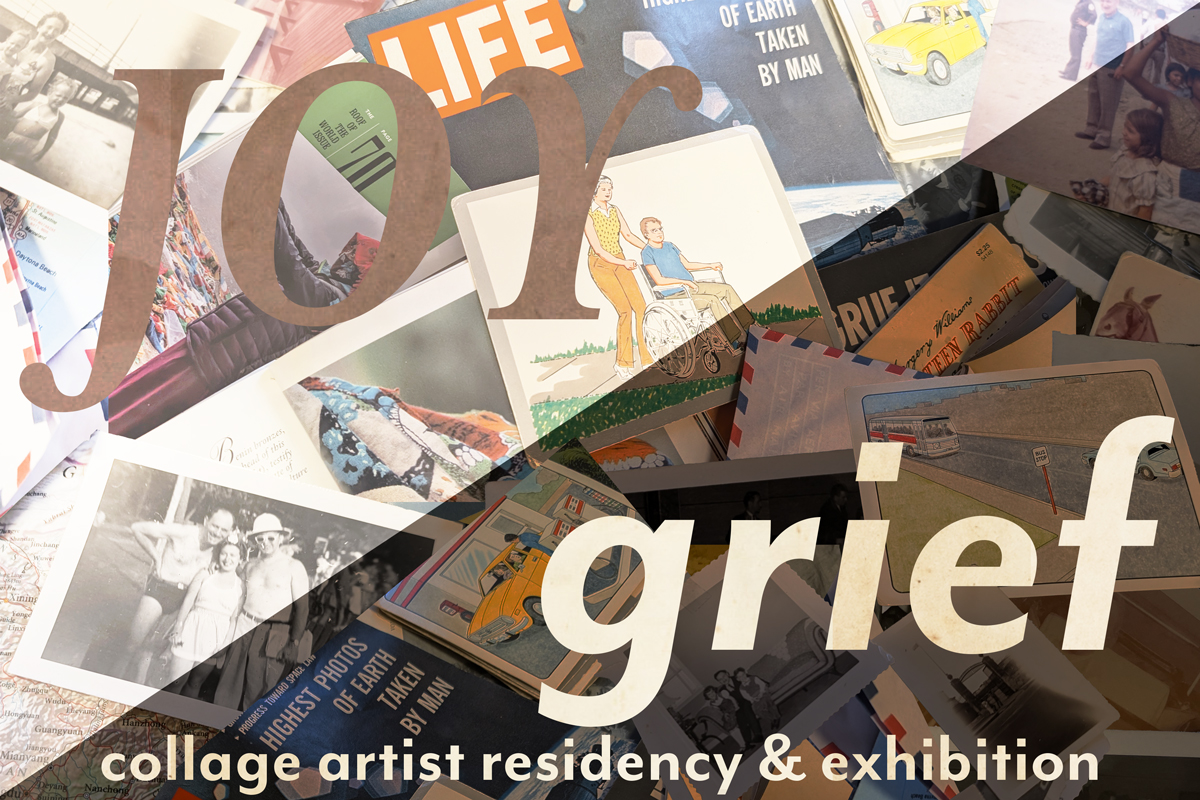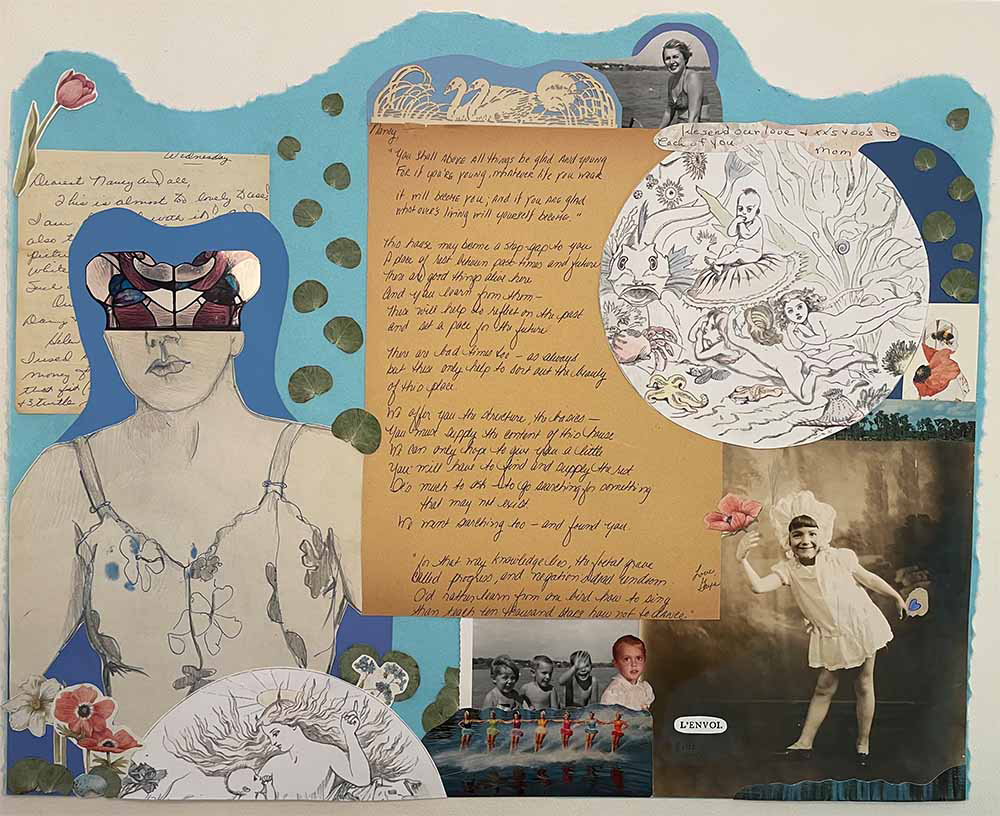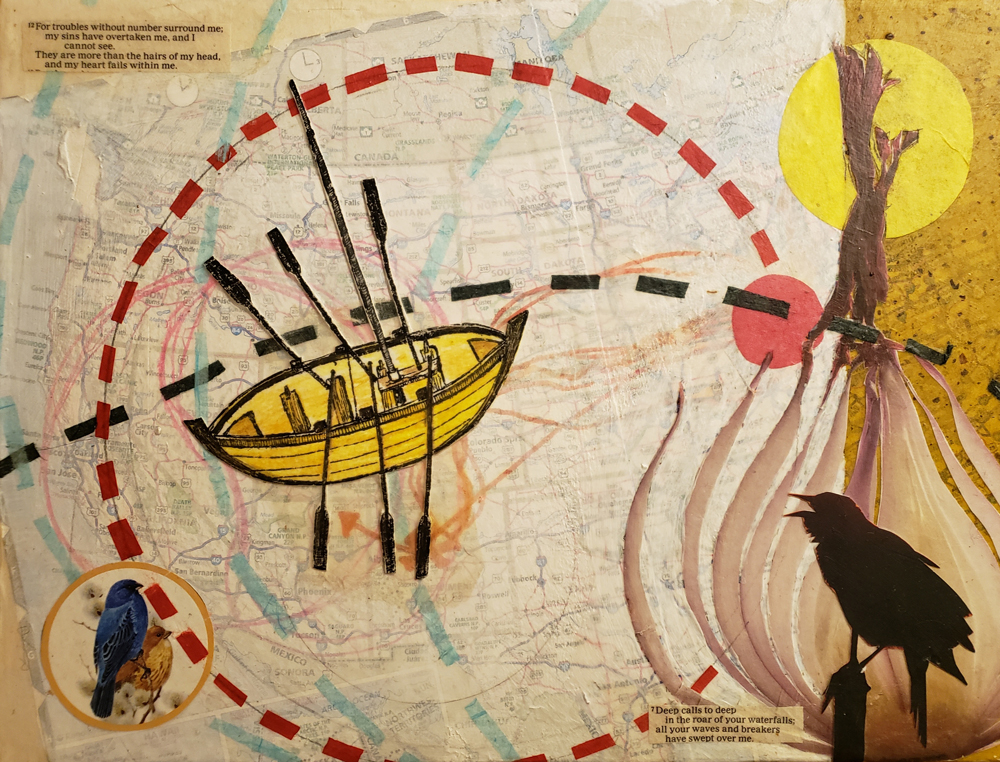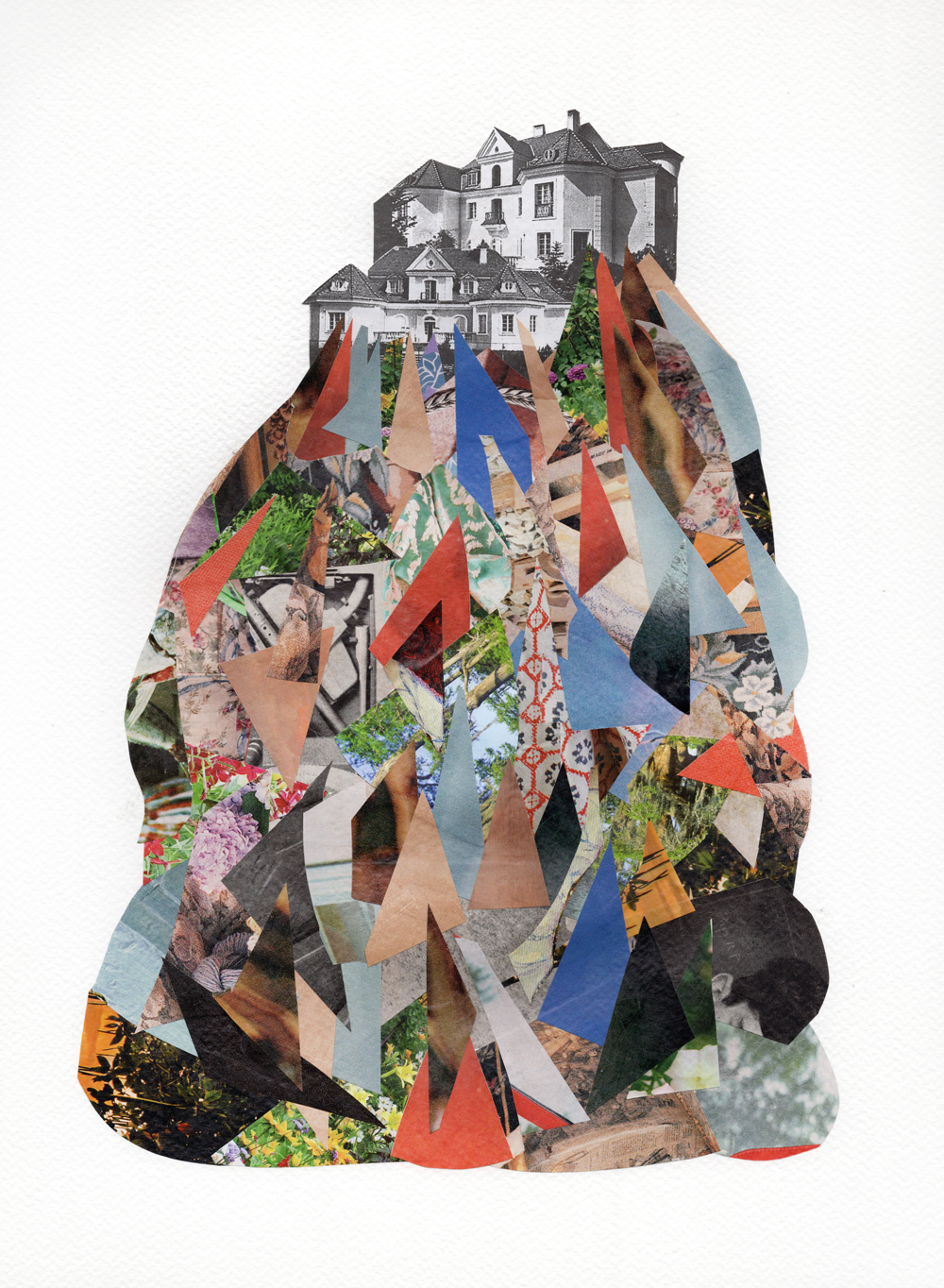
CALL TO ARTISTS
Joy & Grief Virtual Collage Residency
A four-week, virtual/online Residency with Kolaj Institute
Sundays, 9, 16, 23 & 30 March 2025, 4-6PM EDT
Early Deadline to Apply: Wednesday, 19 February 2025
Final Deadline to Apply: Friday, 28 February 2025
Submissions will be reviewed on a rolling basis until space is filled. Artists are encouraged to apply well before the deadline. Also, please note, responses may not be sent out until two weeks after the deadline.
“Find a place inside where there’s joy, and the joy will burn out the pain.” (Joseph Campbell)
Joy and grief: these two deeply human experiences are deeply connected. We don’t understand Joy. Philosophers disagree on what it is, how it is in the world, how to achieve it, what its use is. Religions approach Joy in wildly divergent ways. When asked, people will give you their own definition, usually an example from their own life, suggesting Joy is an idiosyncratic state, unique to the individual. Anyone who has laughed at a funeral can tell you that grief is irrational. To quote the 13th century Persian poet Rumi, sometimes you must “Dance, when you’re broken open.” Rumi goes on to say, “Sorrow prepares you for joy. It violently sweeps everything out of your house, so that new joy can find space to enter. It shakes the yellow leaves from the bough of your heart, so that fresh, green leaves can grow in their place. It pulls up the rotten roots, so that new roots hidden beneath have room to grow. Whatever sorrow shakes from your heart, far better things will take their place.” Writers have given us a bounty of self-help books about grief and a vast system (social and cultural) exists to support one experiencing grief, but an equally extensive array of services doesn’t exist to support joy. How can collage artists make art about joy and grief?
In this residency, artists will explore joy and grief and how to make artwork about these subjects. The premise of the residency is that artists who successfully make art about joy and grief have a working theory, bring context to their artwork, embrace the dialectic of joy and grief, and share their work with others.
Artwork made during the residency will be included in the exhibition, “Joy & Grief” that will take place 12 April to 31 May 2025 at Kolaj Institute’s Gallery in New Orleans and be published in a book that will be released at Kolaj Fest New Orleans.
The residency will be led by Kolaj Institute Director Ric Kasini Kadour who will present and discuss the work of contemporary artists who take on joy and grief. Kadour has written about the relationship between grief and art in the 2018 Hyperallergic article, “What a Year of Grief Taught Me About Monuments and Memorials” and he previously explored this subject in the 2024 residency, Joy as Subject: Mardi Gras, and made the film Joy Is Paper. Kadour will serve as lead curator for the exhibition and contribute an essay to the book that will speak to how artists approach these subjects. He wrote, “To understand the importance of joy, we must consider the inescapable reality of grief.”
Artists will hear from New Orleans-based artist Jamie Hughes whose collage installation, Amdalia, explores the loss of her father and mother, in 2024 and 2023 respectively. The artist writes, “Amdalia was born out of grief and trauma, but the collages I created in this period helped me reconnect with the joy, love, and creativity that was the foundation of our Amdal family. This exhibit is my attempt to uplift and honor my family legacy, while still being true to the pain and struggles that are intertwined with our story. The process of analog collage: selecting meaningful pieces, composing them in a new context and framework, and the tactile and emotional experience of assembly, has been extremely therapeutic for me, enabling me to both hold on to the memories and let go of the pain. The exhibit is a collection of those works intertwined with meaningful pieces of my family story, essentially a collage of my grief. While Amdalia is extremely personal, I hope that viewers may be inspired to reconcile dichotomies within their own families and find healing in their own creative processes.”
Artists will also hear from Michigan-based artist Ray Maseman, who is engaged in a project that uses text from the Book of Lamentations as prompts for a collage series. He wrote, “My current work explores and embodies grief as a normal, healthy, and integral, yet difficult and disheartening facet of human existence. The choice of collage for this exploration is intentional. The elements of chance and serendipity inherent in collage mirror the sometimes unpredictable pathways of grief. At the same time, the playfulness of collage allows for being surprised by joy.”
Both Hughes and Maseman will have work in the “Joy & Grief” exhibition.
OUTCOME
Artwork made during the residency will be included in the exhibition, “Joy & Grief”, that will take place 12 April to 31 May 2025 at Kolaj Institute’s Gallery in New Orleans and be published in a book that will be released at Kolaj Fest New Orleans.
Artists will end the residency with a deeper understanding of how to speak to subjects of joy and grief in their artist practice.
WHO IS THIS FOR?
Collage Artist Residencies are intended for self-motivated artists, at any stage in their career, who want to develop their practice by exploring a topic or working method and collaborating with others to produce a final product. Residencies are open to any artist over the age of 21 from anywhere in the world.
HOW TO APPLY
Learn more and apply HERE.
COST
The cost for the Joy & Grief Residency is $500 USD. A limited number of grants is available to offset the workshop fee and reduce barriers to participation in the program, particularly for those artists coming from places in the world that face historic economic disadvantages. Follow the link in the How to Apply section above to learn more.
QUESTIONS
If you have questions, send an email.
GUEST SPEAKERS

19″x23″; collage; 2023. Courtesy of the artist.
Jamie Hughes
New Orleans-based artist Jamie Hughes specializes in analog collage, using primarily personal and historical materials. Having watched her parents struggling with their creative identities, Hughes herself deflected her own early artistic passions and focused on a successful career as a realtor. Even this choice of profession, however, kept her connected to her home city of New Orleans and the themes of home, family and transition that would later emerge in her work. It was her mother’s death in 2023, however, that reconnected her with the artistic talents and the passions she shared with her mother and prompted a healing journey of mourning, serendipity, release and eventually blossoming. The very day after her mother’s memorial she applied, and was accepted, to Kolaj Institute’s Collage Artist Residency Scotland: Folklore, Place & Collage in September 2023. Once again her deep New Orleans roots supported her in both comfort and spreading her wings. She felt her mother’s encouragement throughout the process. A new chapter in her life as an artist, daughter, woman and mother had begun. This also gave her the tools to process the illness and death of her father, which had occurred in 2022, as well as a fire at the home of her brother. Her body of work was born of her reflections and experiences during this time. Knowing the power of collage for processing trauma, she is particularly interested with the dialogue around collage as a therapeutic tool for healing. Instagram @artamdalia

9″x12″; paper, acrylic gel medium, ink, colored pencil, wood; 2020. Courtesy of the artist.
Ray Maseman
A printmaker for over twenty years, Ray Maseman now works primarily in collage. Maseman’s collage work continues the playful layering of line, texture,color and meaning found in his multiple plate etchings. Growing out of both the personal challenges of mid-life and the global challenge of the COVID-19 pandemic, this work departs from his earlier etchings in a greater preoccupation with finding joy in the midst of grief. His interest in mythopoetic and archetypal themes underlying religious imagery and practices continues, embodied most recently in Kolaj Institute’s Collage Artist Residency in Sanquhar, Scotland in 2022. Originally from Chicago, Illinois, Maseman grew up there and in Denver, Colorado, and received his BFA in Printmaking from the University of Denver. After over two decades in the deserts of New Mexico, he now produces collages in his Southwestern Michigan studio. Maseman’s etchings and collages have been exhibited internationally and are in numerous public and private collections around the world. He has been featured in an episode of PBS’s ¡Colores! and Faroe Islands Podcast interviewed him after his 2013 residency in the Faroe Islands. He is also the co-author of New Grounds: The Manual for Non-Toxic Etching. www.raymaseman.com
FACULTY

15″x11″; book illustrations and collage on watercolor paper; 2024. Courtesy of the artist.
Ric Kasini Kadour
Ric Kasini Kadour, a 2020-2021 Andy Warhol Foundation for the Visual Arts Curatorial Fellow, is a writer, artist, publisher, and cultural worker. Working with the Vermont Arts Council, Kadour curated four exhibits: “Connection: The Art of Coming Together” (2017) and Vermont Artists to Watch 2018, 2019 and 2020. In 2017, he curated “The Art of Winter” at S.P.A.C.E. Gallery in Burlington, Vermont. In 2018, Kadour curated “Revolutionary Paths: Critical Issues in Collage” at Antenna Gallery in New Orleans, which bought together collage artists whose work represents the potential for deeper inquiry and further curatorial exploration of the medium; followed in 2019 by “Cultural Deconstructions: Critical Issues in Collage” at LeMieux Galleries in New Orleans, which furthered the conversation; and “Amuse Bouche”, also at LeMieux Galleries in 2023 and 2024. Since 2018, he has produced Kolaj Fest New Orleans, a multi-day festival & symposium about contemporary collage and its role in art, culture, and society. As Curator of Contemporary Art at Rokeby Museum in Ferrisburgh, Vermont in 2019 and 2020, he curated three exhibitions, “Rokeby Through the Lens” (May 19-June 16, 2019), “Structures” (August 24-October 27, 2019), and “Mending Fences: New Works by Carol MacDonald” (July 12-October 25, 2020). He also curated “Contemporary American Regionalism: Vermont Perspectives” (August 17-October 20, 2019); “Where the Sun Casts No Shadow: Postcards from the Creative Crossroads of Quito, Ecuador” (November 1-30, 2019); and “Many Americas” (August 20-November 27, 2022) in the Wilson Museum & Galleries at the Southern Vermont Arts Center. “The Money $how”, co-curated with Frank Juarez, was presented at the AIR Space Gallery at Saint Kate-The Arts Hotel in Milwaukee, Wisconsin (April 10-September 12, 2021). For Birr Vintage Week & Arts Festival in Birr, County Offaly, Ireland (August 13-20, 2021), he curated “Empty Columns Are a Place to Dream”, which traveled to the Knoxville Museum of Art in January-February 2022. At 516 ARTS in Albuquerque, New Mexico, Kadour co-curated with Alicia Inez Guzmàn two exhibitions: “Many Worlds Are Born” (February 19-May 14, 2022) and “Technologies of the Spirit” (June 11-September 3, 2022). In 2023 at the Knoxville Museum of Art, Kadour curated “Where the Sun Casts No Shadow: Postcards from the Creative Crossroads of Quito, Ecuador” (January 9-February 16, 2023) and “Mythical Landscape: Secrets of the Vale” (March 17-May 28, 2023). In September 2023, he curated “Word of Mouth: Folklore, Community and Collage” at A’ the Airts in Sanquhar, Scotland. His first short film, The Covenant of Schwitters’ Army, debuted at Collage on Screen during Kolaj Fest New Orleans 2023. His second, Joy Is Paper, debuted at Collage on Screen during Kolaj Fest New Orleans 2024.
At the Kolaj Institute Gallery, Kadour curated “Kolaj Institute Grand Opening Exhibition” (March 9-April 14, 2024); “Collage the Planet: Environmentalism in Art” (April 19-May 26, 2024); “Magic in the Modern World” (June 1-August 11, 2024); “Advanced Wound Healing Techniques: Collage by Robbie Morgan” (August 16-October 6, 2024); “Temporal Geolocation: How Place & History Inform Identity in Collage” (October 11-November 24, 2024; and “Camera & Collage” (November 29, 2024-January 25, 2025).
Kadour is the editor and publisher of Kolaj Magazine. He has written for a number of galleries and his writing has appeared in Hyperallergic, OEI, Vermont Magazine, Seven Days, Seattle Weekly, Art New England (where he was the former Vermont editor) and many others. Kadour maintains an active art practice and his photography, collage, and sculpture have been exhibited in and are part of private collections in Australia, Europe and North America. In January-February 2020, he was artist-in-residence at MERZ Gallery in Sanquhar, Scotland. He holds a BA in Comparative Religion from the University of Vermont. Kadour splits his time between Montreal and New Orleans. www.rickasinikadour.com
